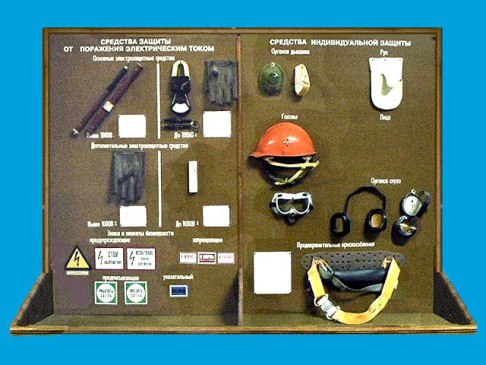Electrical safety devices for electrical installations with a voltage of up to 1000 V
Basic electrical safety devices in electrical installations with a voltage of up to 1000 V
The main electrical protective equipment in electrical installations with a voltage of up to 1000 V are dielectric gloves, insulating rods, insulating and electrical pliers, assembly and assembly tools with insulating handles and voltage indicators.
The most widely used are dielectric gloves made of rubber. Gloves should be checked for leaks before use. Do not use leaking gloves.
Installation tool with insulating handles used when performing work under voltage 220/380 V. Commonly used are single-ended wrenches, screwdrivers, pliers, wire cutters, knives with insulating handles. The insulation of the handle of the tool, made of plastic, is the main means of protection.
Use to check the presence or absence of voltage on live parts without determining its value voltage indicators: two-pole, operating on active current, — for alternating and direct electrical installations with a voltage of up to 500 V and single-pole, operating on capacitive current , — for alternating current electrical installations with a voltage of up to 380 V. The indicator is a gas discharge lamp. Bipolar voltage indicators have two probes connected by a flexible wire.
For their operation, it is necessary to simultaneously touch two phases or to one phase and a neutral wire. Single-pole voltage indicators made in the form of a pen. For their operation, it is enough to touch the probe to a current-carrying part of the electrical installation and with your hand to the metal contact in the upper part of the structure. In this case, the current flows through the human body and the ground. It is recommended to use single-pole indicators when checking secondary switching circuits, determining the phase wire when connecting electricity meters, cartridges, switches, fuses, etc.
 Insulation pliers are used for operations with tube fuse inserts, as well as for inserting single-pole disconnectors on knives and removing caps. Insulating rockets are made of plastic.
Insulation pliers are used for operations with tube fuse inserts, as well as for inserting single-pole disconnectors on knives and removing caps. Insulating rockets are made of plastic.
Additional electrical protective devices in electrical installations with a voltage of up to 1000 V
Additional electrical protective equipment is dielectric boots (boots), boots, dielectric rubber mats, rails and insulating supports.
Dielectric boots, galoshes and boots are used to isolate a person from the base on which he stands.Boots are used in electrical installations of any voltage, and galoshes and boots are used only at voltages up to 1000 V.
Dielectric carpets and tracks Has insulating bases. They are used in closed electrical installations of any voltage.
Isolation pads also isolate the person from the ground or floor. In electrical installations with a voltage of up to 1000 V, the insulating supports are performed without porcelain insulators, and above 1000 V must be performed on porcelain insulators.
Testing of electrical protective equipment
All electrical protective equipment is subjected to electrical tests to establish its dielectric properties after manufacture, repair and periodically during operation. Before testing, the protective agent is inspected and rejected if there is mechanical damage.
Tests are performed, as a rule, with an alternating current supply frequency. After testing the protective equipment, the testing laboratory places a seal certifying their suitability for further use.
Test conditions and standards (test voltage, test duration and leakage current) are taken in accordance with PTE. Usually the duration of the test does not exceed 1 minute. Test voltage, as a rule, is assumed equal to three times the voltage of the network of the electrical installation.
The insulating part of the rods and clamps is subjected to increased tension. They are considered to have passed the test if, during the entire test period, no discharges occurred on the surface, no fluctuations in the readings of the instruments were noticed, and after removing the test voltage, the insulating part had no local heating.
Dielectric rubber gloves, boots, galoshes, boots and assembly tools with insulating handles are tested for leakage current in a tap water bath. The leakage current for different products should not exceed 7.5mA under overvoltage. If no damage has occurred and the readings of the milliammeter do not exceed the norm, the product is considered to have passed the test. The handles of voltage indicators are checked for dielectric strength of the insulation with a voltage of 1000 V for 1 min and the ignition threshold of a neon lamp is determined, which should not exceed 90 V. The current during the tests should not exceed 4 mA.
